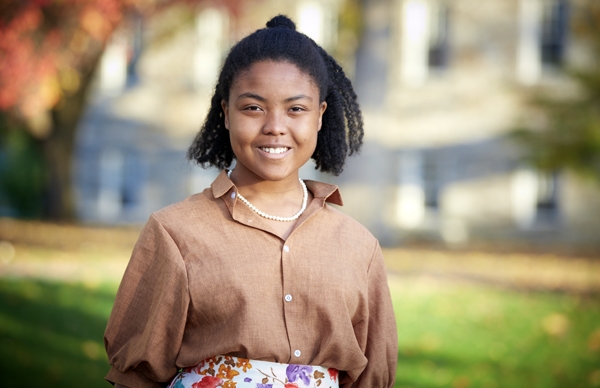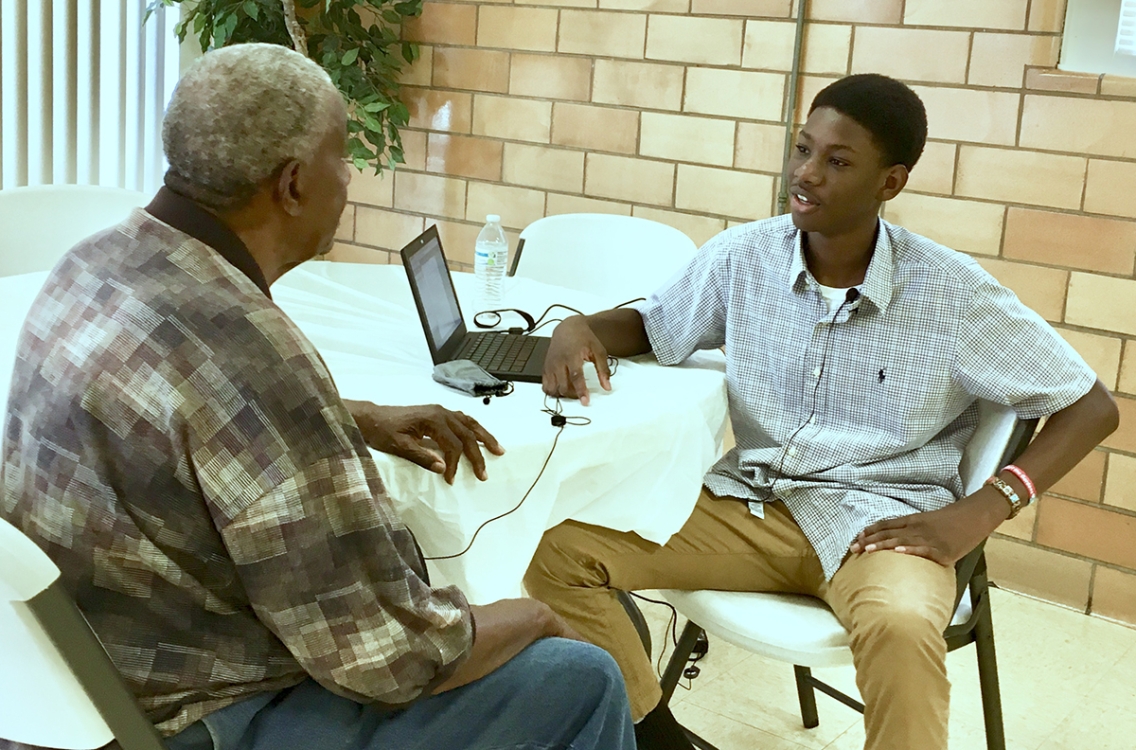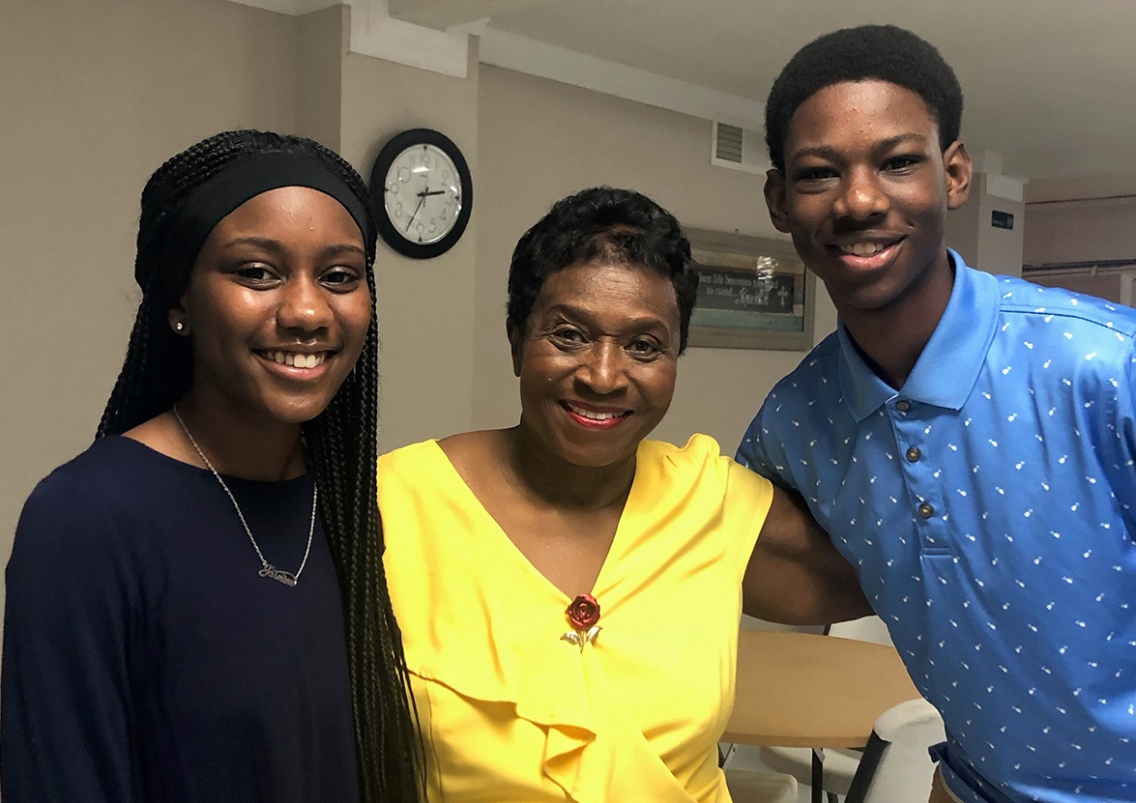Student’s ‘Project for Peace’ Challenges Racism through Oral History
| by Gaen Murphree

MIDDLEBURY, Vt. – Sometimes what’s not on the map is the true guide to history.
Standing in a local history archive surrounded by eight teenagers eager to learn about social justice, Middlebury education and economics major Christine McDow ’21 pointed out an important place in Wilmington, North Carolina. Today it’s a church parking lot. But in 1898 it was the site of Wilmington’s Daily Record, then known as the country’s only African American daily newspaper.
“I showed them where the newspaper was recorded on the map, the original location. Then, if you went to the map five years later, you could see how the newspaper was no longer there,” said McDow.
It had been burned to the ground by an angry mob of white supremacists—the first volley in a carefully orchestrated series of violent events that overthrew Wilmington’s rightfully elected multiracial government, exiled newspaper editor Alexander Manly and other African American leaders, left anywhere from 12 to over 300 African Americans dead, and destroyed the economic prosperity of Wilmington’s burgeoning black community.
Called alternately a “race riot,” “coup d’état,” and “massacre,” the events of November 10, 1898, hold both local and national significance. Before that date, Wilmington’s multiracial society presented a kind of “City on a Hill” for what post–Civil War America could become. Its aftermath ushered in the Jim Crow era.
“After the newspaper was burned down, there was a kind of silencing of the African American community for about 30 years,” said McDow.
It took over 100 years for the state of North Carolina to officially reexamine the events of 1898. Wilmington itself erected a memorial in 2008. But in the years immediately following the racist violence, its perpetrators were elevated as heroes: one became governor, another a U.S. representative, another a U.S. senator.

A student in Christine McDow’s Wilmington, N.C., oral history project interviews a Wilmington resident. Photo: Christine McDow
“Listen Witness Amplify,” McDow’s summer 2019 Project for Peace, gave its teenage participants a greater understanding of how such silencing happens, by helping them better understand their own history and better critique systems of racism. It then gave them new tools to break that silence, focusing on the collection of oral histories.
“Peace is disruptive,” wrote McDow in her final project report. “In the American context, we are too often complacent about institutional racism: cycles of oppression that systematically exclude people based on differences of hair and hue… . In post–Jim Crow America, we can only find peace if we intentionally choose to be uncomfortable. We must dig up our buried histories of murder, mayhem, and betrayal; mourn the lives that were stolen; and vow that our children will know their names.”
McDow said she came alive to the power of oral history while in a writing seminar with Mary Ellen Bertolini her first year at Middlebury. Bertolini describes McDow as someone deeply driven to connect heart and intellect and also someone who is “a force of nature” in the ways she turns ideals into action.
Oral histories are powerful, said McDow, because “when we’re able to reinsert humanity back into history, we’re able to gain understanding of the past in a way that really can enlighten the future.”
McDow’s project gathered eight African American teenagers from across the state’s southeastern region together for 14 days.
In week one, McDow took participants to local landmarks, archives, museums, and memorials to explore African American history. They read poems like Dudley Randall’s “Ballad of Birmingham.” They watched films on history, race, and class. They talked about it.
Participants understood racism as “individual acts of meanness,” said McDow, but “they had never really been challenged to see racism as a system of power used to divide and conquer people.”
They told her: “A lot of this history that we’re learning right here in the social justice program, they’re not teaching us in school.”
Week one also focused on introspection, with students writing “I am from” poems and creating collages about their personal aspirations.

Students in Christine McDow’s oral history project with one of their interviewees. Photo: Christine McDow
“We had them try to work on the journey within before they could really tell someone else’s story, because one thing I learned through my education at Middlebury is that learning to tell your own story is really important because your own story is the only story that no one else can tell. Once you’re able to do that, you’re able to engage in academic writing in a whole different way because you’re able to see yourself in someone else’s story.”
In week two, students conducted the oral history interviews, after first observing and then trying their hand at practice interviews.
The interviews focused on local citizens who’d attended, taught at, or been administrators at all-black high schools before desegregation, including Wilmington’s Williston Senior High School and Charles H. Darden High School in Wilson, N.C. The much-beloved schools had been closed and the African American students then bussed to schools that had been all white—with little to no warning to, or input from, the black community.
“I think the understanding that only the African American children were being hurt by segregation kind of affected how policy was implemented,” said McDow. “There was a deficit narrative about the segregated African American schools such that, ‘Oh, there is nothing here. There’s no cultural capital here. So let’s just close it.’ I think we assumed that there was only wealth in the white culture.”
It’s important that we “see the strengths and the cultural wealth that existed in some of these segregated schools,” said McDow, so that we “can we bring that cultural wealth into our integrated schools.”
Among those neglected riches, said McDow, “was an emphasis on really building a community vs. a more individualist narrative of, like, ‘I succeed on my own.’”
As participants conducted their interviews, they repeatedly heard stories about a close-knit community, where lives were interconnected through home, church, and school, and teachers lived just down the street.
“No matter where you lived—from Seabreeze, which was one of the African American beaches in Wilmington, all the way from the north side to the south side—if a student misbehaved in school, the teacher would go knock on their door,” said McDow.
Interviewees described rich offerings in athletics, choirs, and other activities.
“Respect was probably the recurring value that a lot of the participants talked about,” said McDow. “Respect for yourself, respect for teachers, respect for the community. There was a real pride in the community.”
McDow said that, to this day, Williston alumni hold regular gatherings to remember their school.
Wilmington attorney Erma Johnson, who lent a hand as an interviewee for the practice interviews, observed that the program had a powerful impact on its participants.
“The young people listened to the presenters. They asked questions; and I believe that their lives were changed because of the experience,” said Johnson.
“Christine’s project really exemplifies philanthropist Kathryn W. Davis’s vision of trusting young people to look at their communities in new ways and employ resources to plant seeds for profound change,” said Heather Neuwirth, Middlebury’s Projects for Peace liason and Innovation Hub program director.
The teens closed out the program by giving a speech about a community elder they’d interviewed and what they’d learned from the experience.
One young woman observed: “Coming into this program, I knew I would be learning more about black history, but I had no idea that the people I would be meeting would leave such a huge impact on my perspective and life in general.”
Said a young man, “I think it is important that we know about this history because if we don’t we would only have a single story. But having multiple stories makes you realize the multiple perspectives. It’s important to have multiple perspectives because if there is only one then the other can die out and be easily forgotten. I’m thankful that I got this opportunity to do research on these people so that I can make sure their stories are not forgotten.”
In addition to the $10,000 Projects for Peace award, “Listen Witness Amplify” won funding from Middlebury’s Center for Community Engagement and from the Innovation Hub. In Wilmington, the project drew community support through numerous in-kind donations and volunteers.
By Gaen Murphree; Photos by Todd Balfour and Christine McDow

